I’ve found that adding relaxation-focused yoga poses to my daily routine has changed my life. Yoga does more than just help with physical health; it also boosts mental well-being. This makes it a key part of staying healthy and feeling good.
In this article, I’ll show you the top yoga poses for deep relaxation and feeling refreshed. These poses are great for anyone looking to unwind and rejuvenate.
Key Takeaways
- Explore the most effective yoga poses for relaxation and stress relief
- Understand the mind-body connection and how yoga can promote mental calm
- Learn gentle, restorative yoga practices to support physical and emotional well-being
- Discover techniques to incorporate relaxation yoga into your daily life
- Understand the health benefits of a consistent yoga practice for overall wellness
Mastering the Art of Yoga for Relaxation
Yoga is a practice that connects the mind and body. It helps us understand the mind-body connection. This understanding lets us use yoga for deep stress relief and better mental wellness.
The Mind-Body Connection
Yoga goes beyond just physical exercises. It helps us see how our thoughts, feelings, and body sensations are linked. With mindfulness meditation, we become more aware of the now. This helps us let go of worries and enjoy the calm of the moment.
Setting the Stage for Mindful Practice
Creating a calm space for yoga is key. A quiet, distraction-free area with calming elements tells our body and mind it’s time to relax. This makes the physical exercise of yoga more effective.
“Yoga is not just a workout, it’s a work-in.” – Jillian Pransky
Starting our relaxation techniques journey, we see yoga’s true value. It’s about balancing our mental, emotional, and physical health. This balance leads to deep mental wellness and peace within.

Gentle Yoga Poses for Stress Relief
Keeping our body and mind in balance is key to feeling good overall. Gentle yoga poses are great for managing stress. They help us stay flexible and teach us to breathe deeply, which helps reduce stress.
The Child’s Pose is a top choice for easing stress. It lets us relax and pull inward, creating a peaceful space. By folding forward and resting our forehead on the ground, we let go of tension. This helps us feel safe and grounded.
The Cat-Cow Sequence is another great pose. It mixes flexibility with relaxation. Moving from the Cat Pose to the Cow Pose helps ease back pain and connects our mind and body.
The Forward Fold is also great for reducing stress. Bending forward lets gravity help us relax and breathe deeper. Adding the Ujjayi Breath makes this pose even more calming.
Adding these gentle yoga poses to our routine starts a journey of self-care. By listening to our bodies and being mindful, we can handle life’s challenges better.
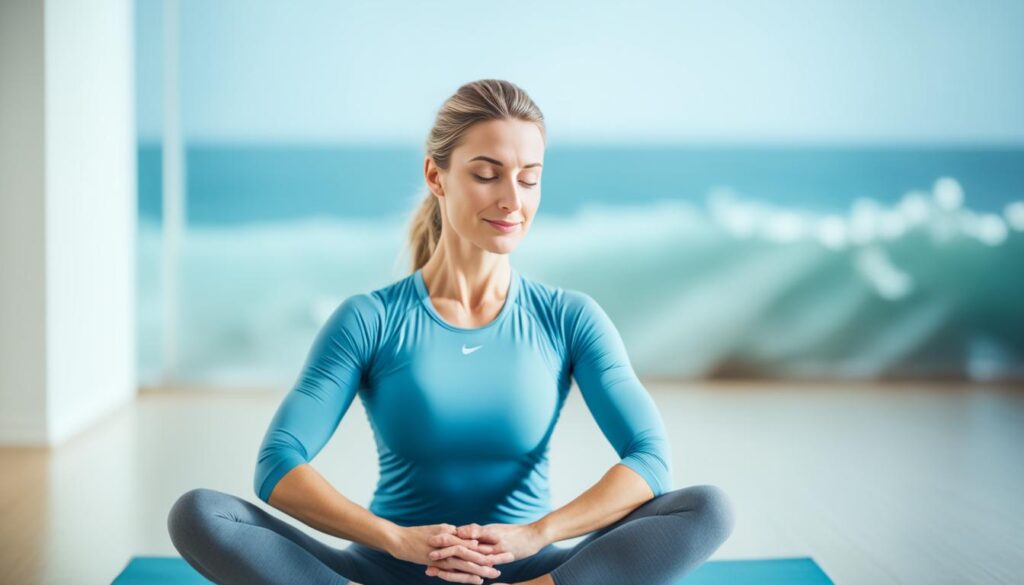
| Yoga Pose | Benefits for Stress Relief |
|---|---|
| Child’s Pose | Promotes a sense of safety and grounding, allows for deep relaxation |
| Cat-Cow Sequence | Enhances flexibility, encourages rhythmic, soothing movement |
| Forward Fold | Releases mental tension, encourages deeper breathing |
“Yoga is the journey of the self, through the self, to the self.” – The Bhagavad Gita
Child’s Pose: A Haven of Tranquility
In the world of yoga poses, the Child’s Pose is a key spot for peace and healing. It’s a pose that asks us to let go and find peace in the now. By using the relaxation techniques it offers, we tap into deep healing powers.
Embracing the Restorative Power
The Child’s Pose, or Balasana, is a soft physical exercise. It stretches the back, hips, and thighs while helping us breathe more calmly. Folding over and resting our forehead on the mat makes us feel safe and comfortable. This lets our body and mind relax deeply.
“The Child’s Pose is a haven of tranquility, a place where we can retreat from the stresses of daily life and reconnect with the quiet within.”
When we get into the Child’s Pose, we focus on our breath. With each breath in, our body opens up. With each breath out, we let go more. This breathing helps calm our nerves, bringing peace and calm inside us.
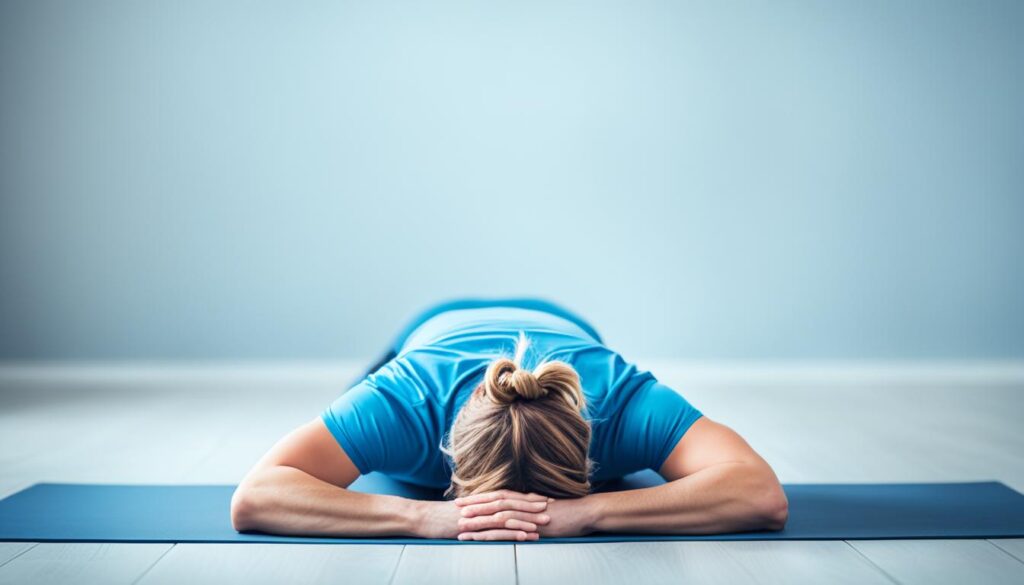
Doing the Child’s Pose often can greatly help our body and mind. It can ease anxiety, stress, and feeling overwhelmed. It also boosts our emotional and physical health. If you need a break or just want peace, the Child’s Pose is a perfect choice.
Cat-Cow Pose: Flexibility and Relaxation
The Cat-Cow Pose is a gentle yoga sequence. It helps improve spinal flexibility and promotes deep relaxation. By smoothly moving between these two postures, you stretch your back and breathe deeply.
Start on your hands and knees. Make sure your wrists are under your shoulders and your knees are under your hips. As you breathe in, arch your back, drop your belly, and lift your head and tailbone. This opens your chest for a deeper breath.
When you breathe out, round your spine, tuck your chin, and pull your navel towards your spine. This turns into the Cat Pose. It helps release tension in your back and neck.
- Inhale, move into Cow Pose: Arch your back, drop your belly, lift your head and tailbone.
- Exhale, move into Cat Pose: Round your spine, tuck your chin, draw your navel in.
- Repeat this fluid sequence, focusing on your breath and the gentle movement of your spine.
The Cat-Cow Pose is great for body flexibility and relaxation. It uses a flowing breath and movement. Adding this pose to your yoga poses routine helps you connect with your body and mind. It also brings you deep relaxation.
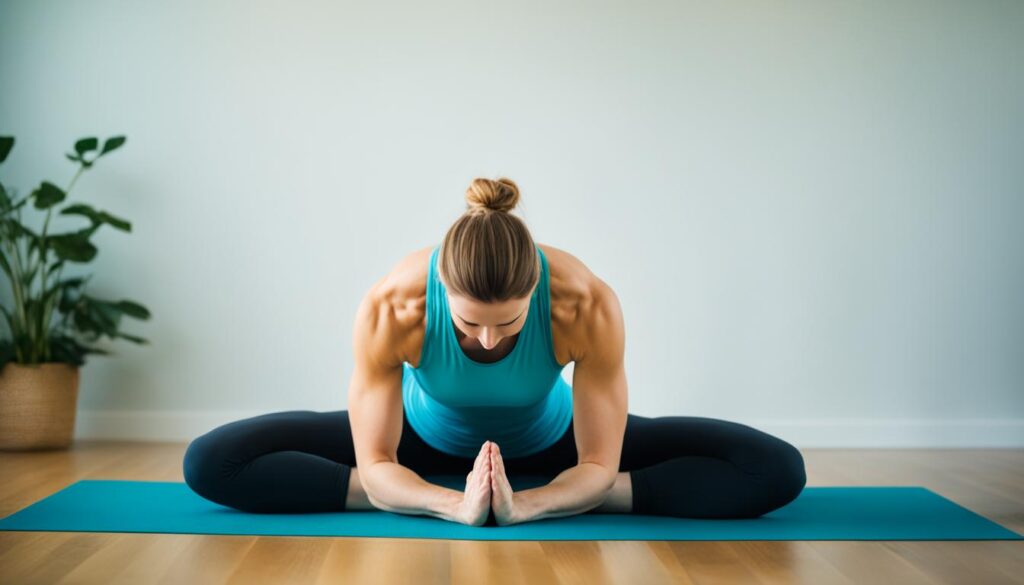
Forward Fold: Releasing Mental Tension
Yoga poses are great for both your body and mind. The Forward Fold, or Uttanasana, is a key pose for easing tension and finding calm. It stretches your hamstrings and back while calming your mind.
Breathing Techniques for Deeper Relaxation
Adding mindful breathing to the Forward Fold makes it a perfect retreat for your body and mind. Certain breathing exercises can enhance this pose’s calming effects, leading to deeper relaxation.
- Start with your feet hip-width apart. Breathe in deeply, raising your arms above.
- As you breathe out, fold forward, letting your torso rest on your thighs. Let your head hang down, releasing neck and shoulder tension.
- Focus on your breath as you move in and out of your body. Make your breaths longer and more focused.
- Stay in the pose for 5-10 breaths, letting your muscles relax and your mind calm.
- Slowly come back up to standing, feeling more relaxed and clear-headed.
Moving with your breath can deepen your yoga, relaxation, and mindfulness. This helps release tension in both your body and mind.

“The practice of yoga is a journey of the self, through the self, to the self.” – The Bhagavad Gita
Using the Forward Fold with mindful breathing helps you step away from the outside world. It connects you with your inner self. This simple pose opens the door to deeper relaxation and self-discovery.
Seated Twist: Unlocking the Body’s Energy
Yoga poses are more than just exercise. They open the door to better health and well-being. The Seated Twist is a key pose that helps unlock energy flow and brings deep relaxation.
This pose stretches the spine, making it more flexible and mobile. It helps with digestion by stimulating organs and releasing toxins. It also calms the mind, leading to peace and well-being.
To do the Seated Twist, sit on the floor with your legs out in front. Bend your right knee and place your right foot on the floor. Twist your torso to the right, putting your left elbow on the outside of your right knee. Hold it for a few breaths, feeling the stretch in your spine, then switch sides. Breathe deeply and let go of any tension or stress.
“The Seated Twist is a powerful pose that can help restore balance and harmony within the body and mind. It’s a simple yet profoundly calming practice that I recommend to anyone seeking greater relaxation and inner peace.”
The Seated Twist is great for easing physical discomfort or improving mental and emotional health. It’s a valuable part of your yoga practice. Let this pose unlock the energy inside you.
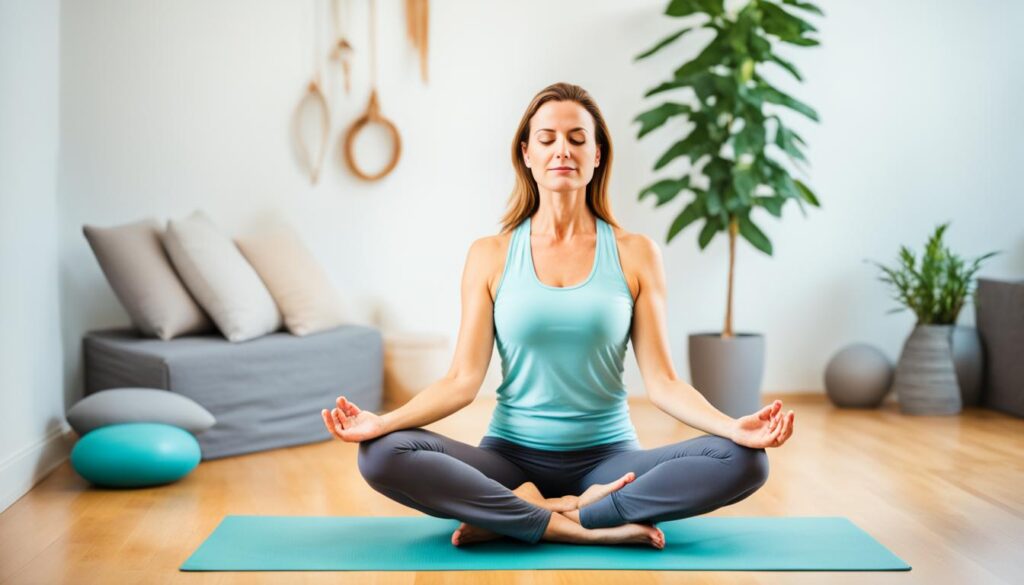
Legs-Up-the-Wall Pose: Rejuvenating Inversions
The Legs-Up-the-Wall Pose, also known as Viparita Karani, is a soothing inversion. It can work wonders for your overall wellbeing. This pose helps reduce fatigue, improve circulation, and promotes deep relaxation. By lifting your legs above your heart, you can enjoy its simple yet effective benefits.
Modifying for Comfort and Safety
Even though the Legs-Up-the-Wall Pose is gentle, it’s key to think about your own needs or limitations. To make sure you’re comfortable and safe, try these adjustments:
- Place a folded blanket or towel under your lower back for extra support.
- Separate your legs slightly if you feel any discomfort in your lower back or hips.
- Use a strap or belt around your thighs to help keep your legs in place, if needed.
- If you have high blood pressure, consult with your healthcare provider before practicing this pose.
Finding the right comfort and support is crucial for a successful Legs-Up-the-Wall Pose. By adjusting and listening to your body, you can fully enjoy the pose’s yoga pose benefits.
“Inversion poses like Legs-Up-the-Wall can help counteract the effects of gravity and improve circulation, promoting a sense of deep relaxation and rejuvenation.”
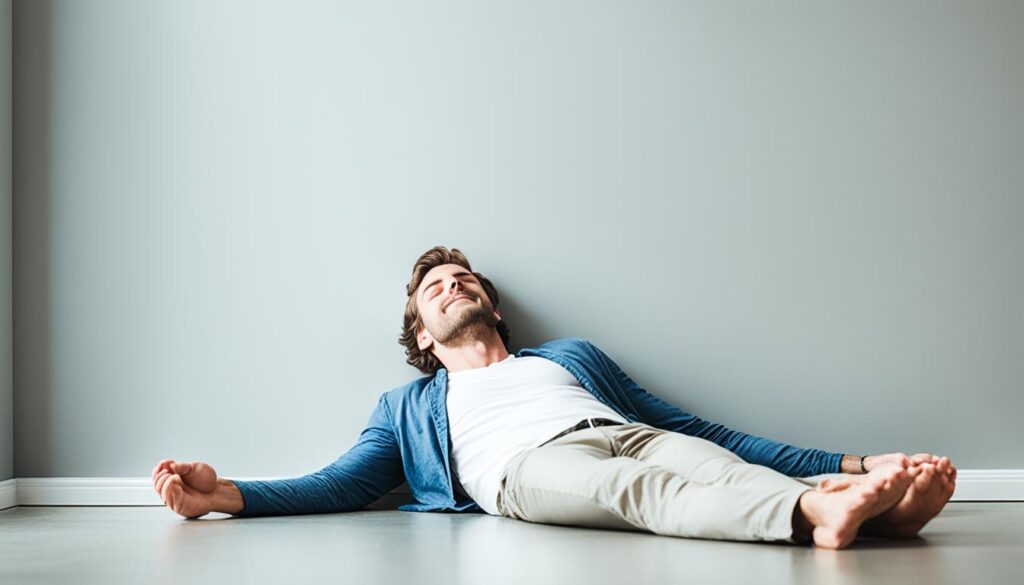
Adding the Legs-Up-the-Wall Pose to your relaxation techniques and physical exercise routine can change your wellness journey. By pausing, inverting, and grounding yourself, you’ll discover a world of restorative benefits. These benefits can leave you feeling refreshed, revitalized, and more in tune with your body and mind.
Corpse Pose: The Ultimate Relaxation Technique
The Corpse Pose, or Savasana, is a key part of yoga. It’s a simple yet powerful way to relax the body and mind. This pose helps us let go and unwind, using yoga poses, relaxation techniques, and mindfulness meditation.
This pose means lying down with your arms and legs relaxed at your sides. Your palms face up. It helps your body release tension and your mind stop racing with thoughts. By focusing on your breath, you can enter a deep state of calm.
“In the Corpse Pose, we surrender to the present moment, embracing the beauty of just being.” – Yoga Instructor, Jane Doe
The Corpse Pose has many benefits. It can reduce stress, lower blood pressure, and improve overall well-being. It helps us be fully present, disconnect from the world, and connect with our inner selves.
Adding the Corpse Pose to your yoga routine can help you rest deeply, clear your mind, and find peace. Try it after a yoga session or as a standalone relaxation method. It’s a powerful way to use yoga poses, relaxation techniques, and mindfulness meditation.
Yoga Poses, Relaxation Yoga, Health Benefits of Yoga, Yoga Practice, Mindfulness
Yoga is more than just poses and stretches. It’s a way to relax, balance, and improve your health. We’ve looked at how certain yoga poses can help with stress, flexibility, and inner peace.
Yoga is known for its health benefits. Regular practice can lower anxiety, improve sleep, and boost your immune system. Adding mindfulness to your yoga can make these benefits even better. It helps you stay in the moment and connects your mind and body.
- Yoga poses like child’s pose, cat-cow, and forward fold help ease mental and physical stress.
- Relaxation yoga uses gentle poses and breathing to bring deep calm and relaxation.
- Yoga improves both physical and mental health. It lowers blood pressure, helps your heart, and makes you feel better emotionally.
- Regular yoga practice makes you more flexible, balanced, and aware of yourself.
- Adding yoga and mindfulness to your day helps manage stress and grow personally.
Yoga and mindfulness are great for everyone, whether you’re new or experienced. They offer many benefits for your body, mind, and heart. By exploring these practices, you can find yourself and feel more peaceful and resilient.
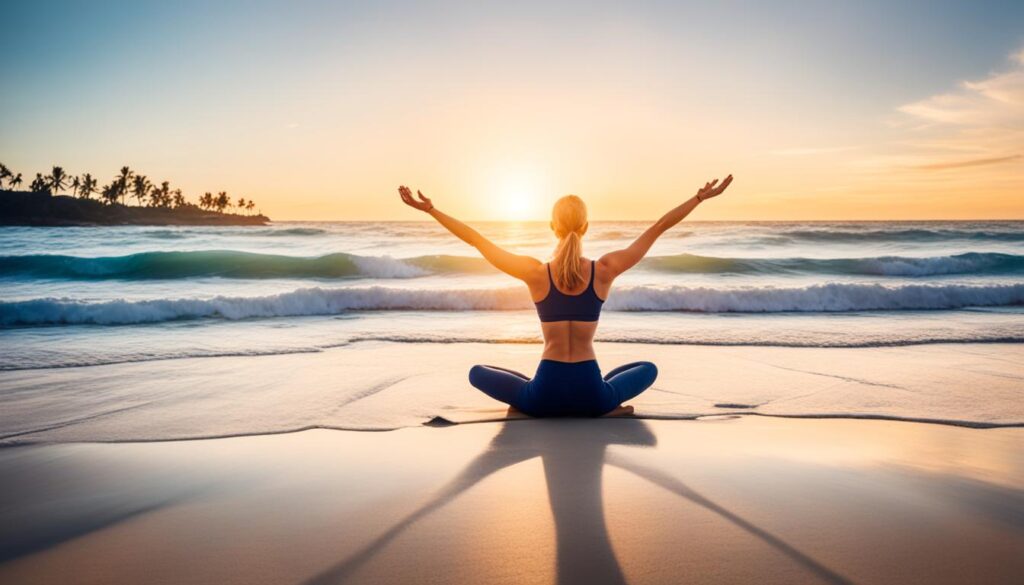
Keep exploring yoga and its many benefits. Be patient, curious, and open to the present. This way, you’ll truly understand yoga and find balance, harmony, and well-being.
Incorporating Relaxation into Your Daily Routine
In today’s fast-paced world, finding calm is crucial. Adding relaxation techniques, like mindfulness meditation, helps fight stress relief. It also brings inner peace.
Finding Moments of Calm
Start by adding small steps to your day for relaxation. Here are some ideas:
- Take a few deep breaths during your commute or while waiting in line.
- Engage in a brief mindfulness meditation during your lunch break.
- Practice a gentle yoga pose, such as child’s pose or forward fold, before bed.
- Disconnect from digital devices for 30 minutes each evening to unwind.
- Keep a gratitude journal to focus on the positive aspects of your day.
Adding these small moments of relaxation techniques to your day helps you feel calm and balanced. This can greatly improve your well-being.
“The greatest weapon against stress is our ability to choose one thought over another.” – William James
Start small and find what works for you. Try different relaxation techniques and be patient. Your mind and body will appreciate it.

The Power of Breathwork in Yoga Practice
As a dedicated yoga practitioner, I’ve learned that yoga’s true power isn’t just in the poses. It’s in the art of breathwork. Conscious, mindful breathing is key. It can make your yoga practice better and improve your well-being.
Breathing exercises add a new layer to your yoga routine. They help you relax and think more clearly. By paying attention to your breath, you connect your body and mind. This reduces stress and anxiety.
Whether you’re new to yoga or have been practicing for years, adding breathing exercises to your physical exercise can change your mental wellness for the better. Synchronizing your breath with your movements helps you stay present and peaceful. This peace goes beyond just your yoga mat.
Try these simple yet powerful breathwork techniques to see the change for yourself:
- Diaphragmatic breathing: Inhale deeply, letting your belly expand, and exhale slowly, releasing tension or anxiety.
- Box breathing: Inhale for a count of four, hold for four, exhale for four, and hold for four before starting again.
- Alternate nostril breathing: Close one nostril with your thumb and the other with your forefinger, switching with each breath.
Adding these breathing exercises to your yoga routine opens up a new level of relaxation and mental clarity. Embrace breathwork to see how it can transform your mind, body, and spirit.
Yoga for Mental Health and Well-being
Yoga is more than just a way to stay fit; it’s a key to mental wellness and peace. When we dive into yoga practice, we see how it changes our emotional and mental health.
Cultivating Inner Peace
Yoga brings balance to our mind, body, and spirit. With yoga practice, we start a journey to understand ourselves better. We learn to calm our minds and find peace inside.
This kind of yoga helps us get better at handling stress, anxiety, and depression. It teaches us to be more aware of our feelings.
Adding yoga practice to our daily routine can change our lives. It mixes physical moves, breathing exercises, and being mindful. This helps us feel peaceful inside and connects us more with our spiritual practice and overall health.
“Yoga is the journey of the self, through the self, to the self.” – The Bhagavad Gita
Yoga teaches us to live in balance and harmony. It makes our emotions, thoughts, and body work together for better mental wellness.
Yoga is not just a workout; it’s a deep spiritual practice that changes our mental health and well-being.
Combining Yoga with Meditation for Holistic Wellness
Take your yoga practice to the next level by adding meditation. This mix of practices brings deep relaxation and rejuvenation. It feeds your body, mind, and spirit.
Adding mindfulness meditation to your yoga makes the connection between your mind and body stronger. As you move through poses, focus on your breath. This helps you relax deeply and find peace. It also quiets your mind, bringing clarity and emotional balance.
Try combining yoga practice and mindfulness meditation for holistic health. This blend of practices changes you deeply. You’ll feel refreshed, balanced, and ready to handle life’s challenges with ease.

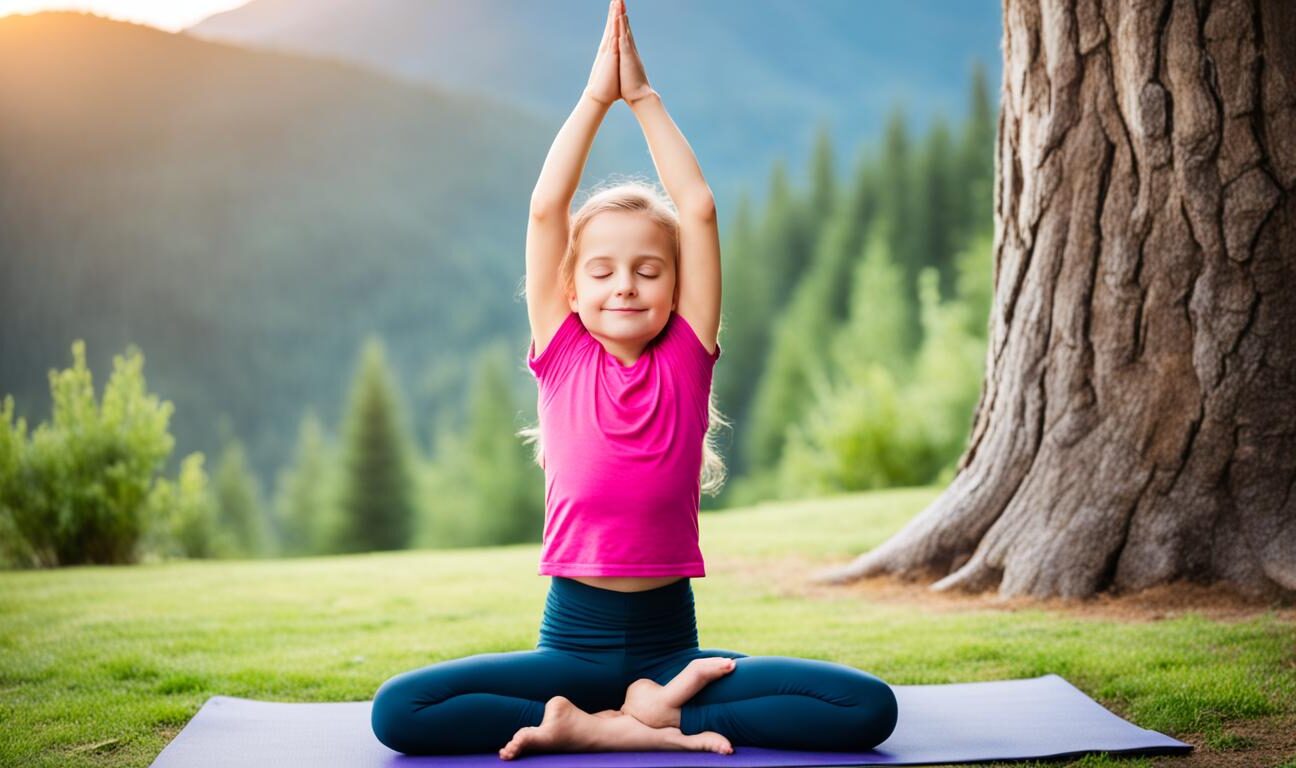
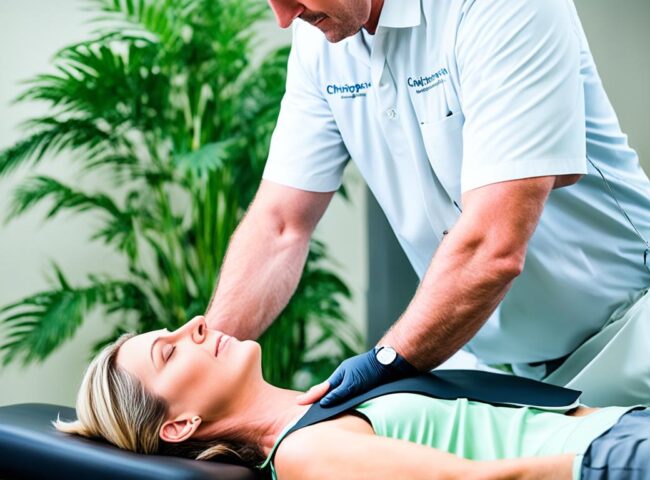


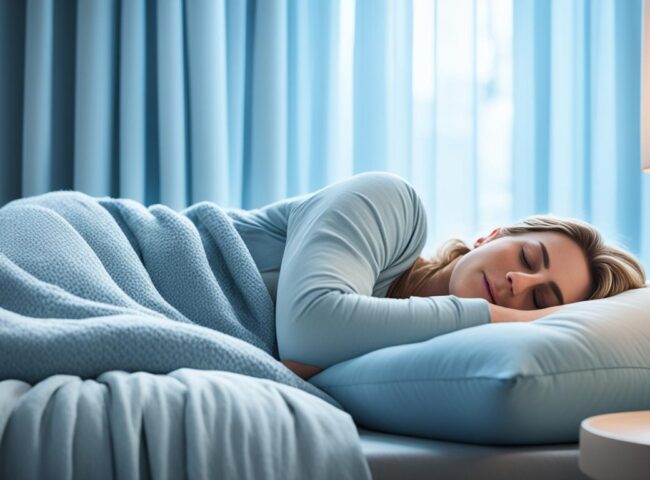

Leave feedback about this